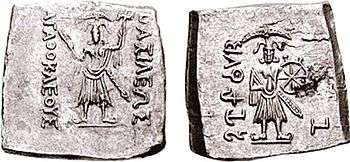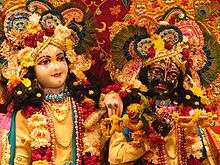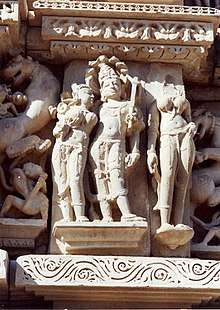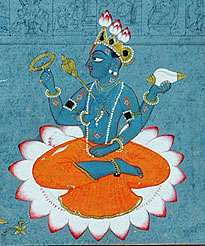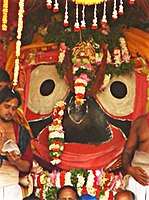Balarama
Balarama (Sanskrit: बलराम, IAST: Balarāma) is a Hindu god and the elder brother of Krishna. He is particularly significant in the Jagannath tradition, as one of the triad deities.[1] He is also known as Baladeva, Balabhadra, Haladhara and Halayudha.[1][2] The first two epithets refer to his strength, the last two associate him with Hala (Langala, "plough")[3] from his strong associations with farming and farmers, as the deity who used farm equipment as weapons when needed.[1][4]
| Balarama | |
|---|---|
God of Agriculture and Strength | |
 Balarama, brother of lord lord Krishna | |
| Affiliation | Avatar of Shesha Naga, brother of lord Krishna, 8th avatar of Vishnu |
| Weapon | Plough, Gada |
| Personal information | |
| Born | |
| Parents | Vasudeva (father) Rohini Devi (mother) Nanda (foster father) |
| Siblings | Krishna and Subhadra |
| Consort | Revati |
| Children | Nisatha (son)
Ulmuka (son) Shashirekha/Vatsala (daughter) |
| Part of a series on |
| Vaishnavism |
|---|
 |
|
Holy scriptures
|
|
Sampradayas
|
|
Related traditions |
|
|
In ancient Hinduism and Hindu texts, Balarama is an avatar of abhishek the god of prosperity [5], and he is replaced by the founder of Buddhism, Buddha, in the list of Dashavatar of Vishnu.[1]
Balarama's significance in the Indian culture has ancient roots. His image in artwork is dated to around the start of the common era, and in coins dated to the 2nd-century BCE.[6] In Jainism, he is known as Baladeva and has been a historically significant farmer-related deity.[7][8]
History
Balarama is an ancient deity, a prominent one by the epics era of Indian history as evidenced by archeological and numismatic evidence. His iconography appears with Nāga (many-headed serpent), a plough and other farm artifacts such as a watering pot, possibly indicating his origins in a bucolic, agricultural culture.[9] Balarama's legend appears in many Parva (books) of the Mahabharata. The Book Three (Vana Parva) states about Krishna and him that Balarama is an avatar of Vishnu, while Krishna is the source of all avatars and existence. In some art works of the Vijayanagara Empire, temples of Gujarat and elsewhere, for example, Baladeva is the eighth avatar of Vishnu, prior to the Buddha (Buddhism) or Jina (Jainism).[10][11]
Texts
Narratives of Balarama are found in Mahabharata, Harivamsha, Bhagavata Purana, Krishna Charit Manas and other Puranas. He is classified in the Vyuha avatar Sankarshana where in Adishesha and Lakshmana are part of.[12] The legend of him as the incarnation of Adishesha, the serpent Vishnu rested on, reflects his role and interconnection with Vishnu.[13] However, the Balarama's mythology and his association with the ten avatars of Vishnu is relatively younger, that is post-Vedic though ancient, because it is not found in the Vedic texts.[14]
Balarama finds a mention in Kautilya's Arthashastra (4th to 2nd century BCE), where according to Hudson, his followers are described as "ascetic worshippers" with shaved heads or braided hair.[15]
Balarama, as Baladewa, is an important character in the 11th-century Javanese text Kakawin Bhāratayuddha, the Kakawin poem based on the Mahabharata.[16]
Coins, arts and epigraphy
(2nd century BCE)
Balarama was anciently a powerful local deity named Samkarshana, associated with the local cult of the Vrishni heroes in Mathura from around the 4th century BCE.[20][21] The concept of the avatars of Vishnu formed during the Kushan period in the 3rd to 2nd century CE.[22]
Coins dated to about 185-170 BCE belonging to the Indo-Greek King Agathocles show Balarama's iconography and Greek inscriptions. Balarama-Samkarshana is typically shown standing with a gada in his right hand and holding plough in his left. On the other side of these coins is Vāsudeva-Krishna holding the conch and chakra.
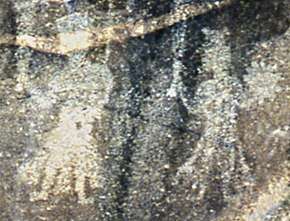
(190-180 BCE)
Obv Balarama-Samkarshana with Greek legend: ΒΑΣΙΛΕΩΣ ΑΓΑΘΟΚΛΕΟΥΣ "King Agathocles".[27]
Rev Vāsudeva-Krishna with Brahmi legend Rajane Agathukleyasasa "King Agathocles".
At Chilas II archeological site dated to the first half of 1st-century CE in northwest Pakistan, near Afghanistan border, are engraved two males along with many Buddhist images nearby. The larger of the two males holds a plough and club in his two hands. The artwork also has an inscription with it in Kharosthi script, which has been deciphered by scholars as Rama-Krsna, and interpreted as an ancient depiction of the two brothers Balarama and Krishna.[28][29] The early Balarama images found in Jansuti (Mathura, Uttar Pradesh) and two at Tumain (Ashoknagar, Madhya Pradesh) are dated to 2nd/1st-century BCE and these show Balarama holding a hala (plough) and a musala (pestle) in his two hands.[30]
In all of these early depictions, Balarama-Samkarsana seems to hold a senior position over Vāsudeva-Krishna.[31] On the coins of Agathocles of Bactria, Balarama is on the front of the coin (side with legend in Greek), whereas Vāsudeva-Krishna is on the reverse (Brahmi side).[31] At Chilas, Balarama is shown taller and bigger than Vāsudeva-Krishna.[31] The same relationship is also visible in the hierarchy of the Vrishni heroes.[31]
In some Indian ancient arts and texts, Balarama (Sankarsana) and Krishna (Vasudeva) are two of the five heroes (Pancaviras of the Vrishnis).[32] The other three differ by the text. In some those are "Pradyumna, Samba and Aniruddha",[33] in others "Anadhrsti, Sarana and Viduratha".[34][35] The 1st-century Mora well inscription near Mathura, dated between 10 and 25 CE, mention the installation of five Vrishni heroes in a stone temple.[36]

The earliest surviving southeast Asian artwork related to Balarama is from the Phnom Da collection, near Angkor Borei in Cambodia's lower Mekong Delta region.[37][38]
Legends

Balarama was the son of Vasudeva. The evil king Kamsa, Vasudeva's brother-in-law, was intent upon killing the children of his sister Devaki because of a prediction that he would die at the hands of her eighth child.[1] Evil demon Kamsa had already killed the first six children of Devaki by smashing the newborns on a stone. Vishnu intervened and when Balarama was conceived, state the Hindu legends, his embryo was moved from Devaki's womb into the womb of Rohini, Vasudeva's first wife.[1][13][39] In some texts, this movement gives Balarama the epithet Sankarshana (one who was dragged away). Balarama grew up with his younger brother Krishna with foster parents, in the household of the head of cowherds Nanda and his wife Yashoda.[1] The chapter 10 of the Bhagavata Purana describes it as follows:
The Bhagavan as the Self of everything tells the creative power of His unified consciousness (yogamaya) about His plan for His own birth as Balarama and Krishna. He begins with Balarama. The whole of Shesha, which is my abode, will become an embryo in Devaki's womb which you shall transplant to Rohini's womb.
He was named Rama, but because of his great strength he was called Balarama, Baladeva, or Balabhadra, meaning Strong Rama. He was born on Shraavana Purnima or Raksha Bandhan.
Childhood and marriage
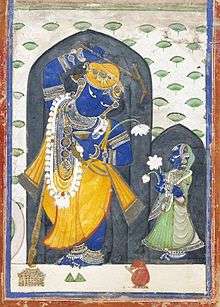
One day, Nanda requested the presence of Sage Gargamuni, his priest, to name the newborn Krishna and Balarama. When the Garga arrived, Nanda received him well and requested the naming ceremony. Gargamuni then reminded Nanda that Kansa was looking for the son of Devaki and if he performed the ceremony in opulence, it would come to his attention. Nanda therefore asked Garga to perform the ceremony in secret and Garga did so:
Because Balarama, the son of Rohini, increases the transcendental bliss of others, his name is Rama and because of his extraordinary strength, he is called Baladeva. He attracts the Yadus to follow his instructions and therefore his name is Sankarshana.
— Bhagavata Purana, 10.8.12[41]
When His elder brother, fatigued from playing, would lie down with His head upon the lap of a cowherd boy, Lord Kṛiṣṇa would help Him relax by personally massaging His feet and offering other services
— Srimad Bhagavatam, Canto 10,Chapter 15, Verse 14[42]
Balarama spent his childhood as a cow herder with his brother Krishna. He killed Dhenuka, an asura sent by Kamsa, as well as Pralamba and Mushtika wrestlers sent by the king. After the evil king died, Balarama and Krishna went to the ashrama of sage Sandipani at Ujjain for study. He married Revati, the daughter of King Kakudmi.[43]
He had 3 children - Nisatha, Uluka and Shashirekha. Shashirekha married the prince of Kashi
Balarama is the celebrated plougher, one of the pillars of agriculture along with livestock with whom Krishna is associated with. The plough is Balarama's weapon. In the Bhagavata Purana, he uses it to fight demons, dig a way for Yamuna river to come closer to Vrindavan and pull the entire capital of Hastinapura into the Ganges river.[15]
Kurukshetra War of Mahabharata

Balarama taught both Duryodhana of the Kauravas and Bhima of the Pandavas the art of fighting with a mace. When war broke between the Kauravas and the Pandavas, Balarama cared for both sides and so remained neutral. He went for a pilgrimage with his nephew Pradyumna and other Yadavas during the war, and returned on the last day, to watch the fight between his disciples. When Bhima defeated Duryodhana by striking him in the thigh with his mace, Balarama threatened to kill Bhima. This was prevented when Krishna reminded Balarama of the vow of Bhima—to kill Duryodhana by crushing the thigh he had exposed to Bhima's wife Draupadi.[44]
Disappearance
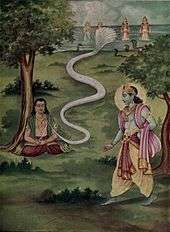
In the Bhagavata Purana, it is described that after Balarama took part in the battle causing the destruction of the remainder of the Yadu dynasty and witnessing the disappearance of Krishna, he sat down in a meditative state and departed from this world.[45]
Some scriptures describe a great white snake that left the mouth of Balarama, in reference to his identity as Ananta-Sesha. The place where he departed is situated near Somnath Temple in Gujarat.
The local people of Veraval believe about the cave near the temple place, that the white snake who came out of Balarama's mouth got into that cave and went back to Paatal Lok.
Significance
In the Hindu traditions, Balarama has been a farmer's patron deity, signifying as one who is "harbinger of knowledge", of agricultural tools and prosperity.[46] He is almost always shown and described with Krishna, such as in stealing butter, playing childhood pranks, complaining to Yashoda that his baby brother Krishna had eaten dirt, playing in cow pens, studying together at the school of guru Sandipani, and fighting evil wrestlers sent in by Kamsa to kill the two brothers.[46] He was the constant companion of Krishna, ever watchful, leading to the epithet "Luk Luk Dauji" (or Luk Luk Daubaba) in the Pustimarga tradition of Vaishnavism.[46][47] He is a creative store of knowledge for the agriculturists: the knowledge that dug a water channel to bring Yamuna water to Vrindavan; that restored groves, farms and forests; that produced goods and drinks.[46][48]
In Hindu texts, Balarama almost always supports Krishna in form and spirit. However, there are occasions where the dialogues between Balarama and Krishna present different viewpoints, with Krishna's wisdom establishing him to be the ultimate divinity.[46] Balarama's constant symbolic association with Krishna makes him the protector and supporter of dharma.[49]
Iconography
%2C_Vasudeva_(Krishna%2C_Jagannath).jpg)
Balarama is depicted as light skinned, in contrast to his brother, Krishna, who is dark skinned; Krishna in Sanskrit means dark.[13] His ayudha or weapons are the plough hala and the mace gadā. The plough is usually called Balachita.[50] He often wears blue garments and a garland of forest flowers. His hair is tied in a topknot and he has earrings, bracelets and armlets; he is known for his strength, the reason for his name.[51]
In the Jagannath tradition, one particularly popular in eastern and central regions of India, he is more often called Balabhadra. Balarama is one in the triad, wherein Balarama is shown together with his brother Jagannath (Krishna) and sister Shubhadra (Subhadra). Jagannath is identifiable from his circular eyes compared to oval of Shubhadra and almond shaped eyes of the abstract icon for Balarama. Further, Balarama's face is white, Jagannath's icon is dark, and Subhadra icon is yellow. The third difference is the flat head of Jagannath icon, compared to the semi-circular carved head of abstract Balarama.[52] The shape of Balabhadra's head, also called Balarama or Baladeva in these regions, varies in some temples between somewhat flat and semi-circular.[52][53]
Sculpture
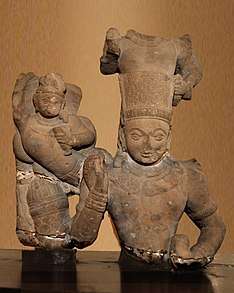 Chatur-vyūha: Balarama, with serpent hood and drinking cup, to the right of Vasudeva-Krishna. 2nd century CE, Art of Mathura.
Chatur-vyūha: Balarama, with serpent hood and drinking cup, to the right of Vasudeva-Krishna. 2nd century CE, Art of Mathura.- Balarama, Gupta period, Mathura
- Balarama, Medieval period, Mathura
- Balarama, 18th century, Mathura
Temples
- Nenmini Balarama Temple Kerala
- Aluva Srikrishna Balarama Temple Kerala
- Mazhoor Balarama Temple, Taliparamba, Kannur district, Kerala
- Six major Balarama temples mentioned in the Puranas: Unchagaon, Aring, Ram Ghat, Baldeo, Nari and Talvan.[46]
- Jagannath temples of Odisha and Jharkhand, particularly Puri
- Kendrapara, Baladevjew Temple
- Ananta Vasudeva Temple
- RevtiBaladevji Mandir, Jetalpur, Gujarat
- Shri Daau Ji Mandir, Vill- Banchari, Haryana
- Kathmandu temples, Nepal[54]
- Shri Dauji Mandir, Mainpuri, (U.P.)
- Shri Shri Baladev Jiu Gopal Jiu Temple, Beliaghata, Kolkata (W.B.)
Outside Hinduism
Jainism
The Jain Puranas, notably, the Triṣaṣṭiśalākāpuruṣacarita of Hemachandra, narrate hagiographical accounts of nine Baladevas or Balabhadras who are believed to be śalākāpuruṣas (literally torch-bearers, great personalities). Balarama was the ninth one.[55] Balarama along with Krishna are considered as cousins of the revered Tirthankara Neminatha (Aristanemi) by Jains.[56]
The Jainism tradition lists 63 Śalākāpuruṣa or notable figures which, amongst others, includes the twenty-four Tirthankaras and nine sets of triads. One of these triads is Krishna as the Vasudeva, Balarama as the Baladeva, and Jarasandha as the Prati-Vasudeva. In each age of the Jain cyclic time is born a Vasudeva with an elder brother termed the Baladeva. Between the triads, Baladeva upholds the principle of non-violence, a central idea of Jainism. The villain is the Prati-vasudeva, who attempts to destroy the world. To save the world, Vasudeva-Krishna has to forsake the non-violence principle and kill the Prati-Vasudeva.[57] The stories of these triads can be found in the Harivamsa Purana (8th century CE) of Jinasena (not be confused with its namesake, the addendum to Mahābhārata) and the Trishashti-shalakapurusha-charita of Hemachandra.[58][59]
The story of Krishna's life in the Puranas of Jainism follows the same general outline as those in the Hindu texts, but in details they are very different: they include Jain Tirthankaras as characters in the story, and generally are polemically critical of Krishna, unlike the versions found in the Mahabharata, the Bhagavata Purana, and the Vishnu Purana.[61] For example, Krishna loses battles in the Jain versions, and his gopis and his clan of Yadavas die in a fire created by an ascetic named Dvaipayana. Similarly, after dying from the hunter Jara's arrow, the Jaina texts state Krishna goes to the third hell in Jain cosmology, while Balarama is said to go to the sixth heaven.[62]
In other Jain texts, Krishna and Baladeva are stated to be a cousin of the twenty-second Tirthankara, Neminatha. The Jain texts state that Naminatha taught Krishna all the wisdom that he later gave to Arjuna in the Bhagavad Gita. According to Jeffery D. Long, a professor of Religion known for his publications on Jainism, this connection between Krishna and Neminatha has been a historic reason for Jains to accept, read, and cite the Bhagavad Gita as a spiritually important text, celebrate Krishna-related festivals, and intermingle with Hindus as spiritual cousins.[63]
Evidence related to early Jainism, states Patrick Olivelle and other scholars, suggests Balarama had been a significant farmer deity in Jain tradition in parts of the Indian subcontinent such as near the Mathura region.[8] Jain texts such as the Kalpasutra describe the same idea of embryo transfer, as in Hindu texts for Balarama, for the 24th Tirthankara Mahavira; in the latter case, the embryo of a Brahmin woman is moved into the womb of a Kshatriya woman.[64] Balarama, states Pratapaditya Pal, was one of the historic deities revered in Jainism along with Ambika, Lakshmi and others.[64][65] As with the Hindu farmers, state Paul Dundas and other scholars, it is likely that Balarama was the patron deity of Jain farmers in the early centuries of the common era, because a large number of Balarama images have been found in early Jain arts.[66][67]
Buddhism
Balarama images have been discovered in central Indian Buddhist sites, such as with Sanchi stupas at Andher, Mehgaon and Chandna. These are dated to around the start of the common era.[68][69] The Ghata Jataka, one of the Jataka Tales that form part of Buddhist scriptures, depicts Balarama as a previous birth of Lord Gautama Buddha and has Krishna depicted as the previous birth of Buddha's disciple Sariputta.
See also
| Wikimedia Commons has media related to Balarama. |
- Hindu deities
- Gefjon – Nordic deity with plough
- Philomelus – Greek deity with plough
- Shamgar – the Biblical hero who kills enemies with farm equipment
References
- James G. Lochtefeld (2002). The Illustrated Encyclopedia of Hinduism: A-M. The Rosen Publishing Group. pp. 82–84, 269. ISBN 978-0-8239-3179-8.
- Jan Gonda (1969). Aspects of Early Viṣṇuism. Motilal Banarsidass. pp. 99–100. ISBN 978-81-208-1087-7.
- Jan Gonda (1969). Aspects of Early Viṣṇuism. Motilal Banarsidass. pp. 100, 152–153. ISBN 978-81-208-1087-7.
- Lavanya Vemsani (2006). Hindu and Mythology of Balarāma. Edwin Mellen Press. pp. 30–31, 52–59, 68–69 with footnotes. ISBN 978-0-7734-5723-2.
- https://www.britannica.com/topic/Balarama#:~:text=Sometimes%20Balarama%20is%20considered%20one,incarnation%20of%20the%20serpent%20Shesha.
- Heather Elgood (1 April 2000). Hinduism and the Religious Arts. Bloomsburg Academic. pp. 57, 61. ISBN 978-0-304-70739-3.
- Vemsani, Lavanya (2006). Hindu and Jain Mythology of Balarama (1 ed.). EdwinMellen. ISBN 9780773457232.
- Patrick Olivelle (2006). Between the Empires: Society in India 300 BCE to 400 CE. Oxford University Press. pp. 391 with note 15. ISBN 978-0-19-977507-1.
- Kenneth W. Morgan (1987). The Religion of the Hindus. Motilal Banarsidass. p. 57. ISBN 978-81-208-0387-9.
- Roshen Dalal (2010). Hinduism: An Alphabetical Guide. Penguin. p. 112. ISBN 978-0-14-341421-6.
- Kenneth W. Morgan (1987). The Religion of the Hindus. Motilal Banarsidass. p. 55. ISBN 978-81-208-0387-9.
- A. C. Bhaktivedanta Swami Prabhupada (1987). Bhaktivedanta Book Trust (ed.). Srimad-Bhagavatam: Bhagavata Purana. ISBN 0892132507.
- Constance Jones; James D. Ryan (2006). Encyclopedia of Hinduism. Infobase Publishing. pp. 65–66. ISBN 978-0-8160-7564-5.
- Padmanabh S. Jaini (1977), Jina Ṛṣabha as an "Avatāra" of Viṣṇu, Bulletin of the School of Oriental and African Studies, Cambridge University Press, Vol. 40, No. 2 (1977), pp. 321–337
- D Dennis Hudson (2008). The Body of God: An Emperor's Palace for Krishna in Eighth-Century Kanchipuram. Oxford University Press. pp. 97–101. ISBN 978-0-19-970902-1.
- Helen Creese (2015). Women of the Kakawin World: Marriage and Sexuality in the Indic Courts of Java and Bali. Routledge. pp. 93, 104–105, 110. ISBN 978-1-317-45179-2.
- "Post-Mauryan punch-marked coin" Srinivasan, Doris (1997). Many Heads, Arms, and Eyes: Origin, Meaning, and Form of Multiplicity in Indian Art. BRILL. p. 215. ISBN 978-90-04-10758-8.
- Mishra, Susan Verma; Ray, Himanshu Prabha (2016). The Archaeology of Sacred Spaces: The temple in western India, 2nd century BCE–8th century CE. Routledge. p. 6. ISBN 978-1-317-19374-6.
- Bopearachchi, Osmund. Emergence of Viṣṇu and Śiva Images in India: Numismatic and Sculptural Evidence.
- Rosenfield, John M. (1967). The Dynastic Arts of the Kushans. University of California Press. pp. 151–152.
- Singh, Upinder (2008). A History of Ancient and Early Medieval India: From the Stone Age to the 12th Century. Pearson Education India. p. 438. ISBN 978-81-317-1677-9.
- Singh, Upinder (2008). A History of Ancient and Early Medieval India: From the Stone Age to the 12th Century. Pearson Education India. p. 439. ISBN 978-81-317-1677-9.
- Srinivasan, Doris (1997). Many Heads, Arms, and Eyes: Origin, Meaning, and Form of Multiplicity in Indian Art. BRILL. p. 215. ISBN 978-90-04-10758-8.
- Iconography of Balarāma, Nilakanth Purushottam Joshi, Abhinav Publications, 1979, p.22
- Osmund Bopearachchi, 2016, Emergence of Viṣṇu and Śiva Images in India: Numismatic and Sculptural Evidence
- Srinivasan, Doris (1997). Many Heads, Arms, and Eyes: Origin, Meaning, and Form of Multiplicity in Indian Art. BRILL. p. 215. ISBN 978-90-04-10758-8.
- Benjamín Preciado-Solís (1984). The Kṛṣṇa Cycle in the Purāṇas: Themes and Motifs in a Heroic Saga. Motilal Banarsidass. pp. 155, see Plate 2. ISBN 978-0-89581-226-1.
- Doris Srinivasan (1997). Many Heads, Arms, and Eyes: Origin, Meaning, and Form of Multiplicity in Indian Art. BRILL Academic. pp. 214–215 with footnotes. ISBN 90-04-10758-4.
- Jason Neelis (2010). Early Buddhist Transmission and Trade Networks: Mobility and Exchange Within and Beyond the Northwestern Borderlands of South Asia. BRILL Academic. pp. 271–272. ISBN 90-04-18159-8.
- Julia Shaw (2016). Buddhist Landscapes in Central India: Sanchi Hill and Archaeologies of Religious and Social Change, c. Third Century BC to Fifth Century AD. Taylor & Francis. p. lxxix. ISBN 978-1-315-43263-2.
- Srinivasan, Doris (1997). Many Heads, Arms, and Eyes: Origin, Meaning, and Form of Multiplicity in Indian Art. BRILL. p. 215. ISBN 978-90-04-10758-8.
- Upinder Singh (2008). A History of Ancient and Early Medieval India: From the Stone Age to the 12th Century. Pearson. p. 437. ISBN 978-81-317-1120-0.
- T. Richard Blurton (1993). Hindu Art. Harvard University Press. p. 50. ISBN 978-0-674-39189-5.
- Parmanand Gupta (1989). Geography from Ancient Indian Coins & Seals. Concept. pp. 57–59. ISBN 978-81-7022-248-4.
- Lavanya Vemsani (2016). Krishna in History, Thought, and Culture: An Encyclopedia of the Hindu Lord of Many Names. ABC-CLIO. pp. 11, 203, 239. ISBN 978-1-61069-211-3.
- Edwin F. Bryant (2007). Krishna: A Sourcebook. Oxford University Press. pp. 18 note 19. ISBN 978-0-19-972431-4.
- Nancy Dowling (1999), A new date for the Phnom Da images and its implications for early Cambodia, Asian Perspectives, University of Hawaii Press, Volume 38, Number 1, pages 54–57
- John Guy; Pierre Baptiste; Lawrence Becker; et al. (2014). Lost Kingdoms: Hindu-Buddhist Sculpture of Early Southeast Asia. Yale University Press. pp. 146–148. ISBN 978-0-300-20437-7.
- Kenneth W. Morgan (1987). The Religion of the Hindus. Motilal Banarsidass. p. 406. ISBN 978-81-208-0387-9.
- D Dennis Hudson (2008). The Body of God: An Emperor's Palace for Krishna in Eighth-Century Kanchipuram. Oxford University Press. pp. 34–35. ISBN 978-0-19-970902-1.
- "Bhagavata Purana 10.8.12". Archived from the original on 12 March 2007.
- https://vedabase.io/en/ https://vedabase.io/en/library/sb/10/15/14/. Retrieved 24 February 2020. Missing or empty
|title=(help); External link in|website=(help) - Pargiter, F.E. (1922, reprint 1972). Ancient Indian Historical Tradition, New Delhi: Motilal Banarsidass, p. 135
- Varkey, C.P. (2001). A Pilgrimage Through The Mahabharata. Mumbai: St. Paul Society. pp. 148–149. ISBN 81-7109-497-X.
- Bhag-P 11.30.26 Archived 26 March 2007 at the Wayback Machine
- Lavanya Vemsani (2016). Krishna in History, Thought, and Culture: An Encyclopedia of the Hindu Lord of Many Names. ABC-CLIO. pp. 23–25. ISBN 978-1-61069-211-3.
- A. Whitney Sanford (2006). Guy L. Beck (ed.). Alternative Krishnas: Regional and Vernacular Variations on a Hindu Deity. State University of New York Press. pp. 91–98. ISBN 978-0-7914-6416-8.
- Lavanya Vemsani (2006). Hindu and Jain Mythology of Balarāma: Change and Continuity in an Early Indian Cult. Edwin Mellen Press. pp. 64–66, 94–100, 116–125. ISBN 978-0-7734-5723-2.
- Lavanya Vemsani (2016). Krishna in History, Thought, and Culture: An Encyclopedia of the Hindu Lord of Many Names. ABC-CLIO. p. 26. ISBN 978-1-61069-211-3.
- Gopal, Madan (1990). K.S. Gautam (ed.). India through the ages. Publication Division, Ministry of Information and Broadcasting, Government of India. p. 75.
- "Appearance of Lord Balaram" Archived 2 December 2013 at the Wayback Machine, Iskondesiretree.com via iskconmanchester.com. Retrieved 2016-09-02.
- Thomas E. Donaldson (2002). Tantra and Śākta Art of Orissa. DK Printworld. pp. 779–780. ISBN 978-81-246-0198-3.
- O. M. Starza (1993). The Jagannatha Temple at Puri: Its Architecture, Art, and Cult. BRILL Academic. pp. 61–64 with footnotes. ISBN 90-04-09673-6.
- Guy, John (1992). "New Evidence for the Jagannātha Cult in Seventeenth Century Nepal". Journal of the Royal Asiatic Society. Cambridge University Press. 2 (02): 213–230. doi:10.1017/s135618630000239x.
- Joshi, Nilakanth Purushottam (1979). Iconography of Balarāma. New Delhi: Abhinav Publications. ISBN 81-7017-107-5., p. 5
- Umakant Premanand Shah (1995). Studies in Jaina Art and Iconography and Allied Subjects. Abhinav Publications. pp. 75–76. ISBN 978-81-7017-316-8., Quote: "Krsna (Vasudeva) and Baladeva or Balarama are regarded as cousin brothers of Neminatha".
- Jaini, P. S. (1993), Jaina Puranas: A Puranic Counter Tradition, ISBN 978-0-7914-1381-4
- Upinder Singh 2016, p. 26.
- See Jerome H. Bauer "Hero of Wonders, Hero in Deeds: "Vasudeva Krishna in Jaina Cosmohistory" in Beck 2005, pp. 167–169
- Devangana Desai (2000). Khajuraho. Oxford University Press. p. 73. ISBN 978-0-19-565391-5.
- Cort, J. E. (1993), Wendy Doniger (ed.), An Overview of the Jaina Puranas, in Purana Perennis, pp. 220–233, ISBN 9781438401362
- Helmuth von Glasenapp (1999). Jainism: An Indian Religion of Salvation. Motilal Banarsidass. pp. 316–318. ISBN 978-81-208-1376-2.
- Jeffery D. Long (2009). Jainism: An Introduction. I. B. Tauris. p. 42. ISBN 978-1-84511-625-5.
- Pratapaditya Pal (1997). Divine Images, Human Visions: The Max Tanenbaum Collection of South Asian and Himalayan Art in the National Gallery of Canada. National Gallery of Canada. pp. 25–26. ISBN 978-1-896209-05-0.
- MNP Tiwari (1995). Umakant Premanand Shah (ed.). Studies in Jaina Art and Iconography and Allied Subjects in Honour of Dr. U.P. Shah. Abhinav Publications. pp. 17–19. ISBN 978-81-7017-316-8.
- Paul Dundas (2003). The Jains. Routledge. pp. 298 note 17. ISBN 1-134-50165-X.
- MNP Tiwari and K Giri (1985), Balarama – The Deity of Krsikarman in Jaina Art, Journal of the Asiatic Society of Bombay, Volume 60, Issue 1, pages 122-125
- Julia Shaw (2016). Buddhist Landscapes in Central India: Sanchi Hill and Archaeologies of Religious and Social Change, c. Third Century BC to Fifth Century AD. Taylor & Francis. pp. 135–139, Figures 141–144, 150. ISBN 978-1-315-43263-2.
- Nilakanth Purushottam Joshi (1979). Iconography of Balarāma. Abhinav Publications. pp. 32–57. ISBN 978-81-7017-107-2.
Bibliography
- Beck, Guy L. (Ed.) (2005). Alternative Krishnas: Regional and Vernacular Variations on a Hindu Deity. SUNY Press. ISBN 0-7914-6415-6.CS1 maint: extra text: authors list (link) CS1 maint: ref=harv (link)
- Doniger, Wendy (1993). Purana Perennis: Reciprocity and Transformation in Hindu and Jaina Texts. SUNY Press. ISBN 0-7914-1381-0.
- Singh, Upinder (2016), A History of Ancient and Early Medieval India: From the Stone Age to the 12th Century, Pearson Education, ISBN 978-93-325-6996-6
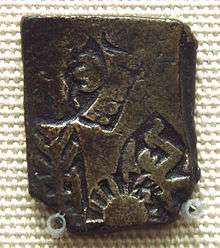
.jpg)
